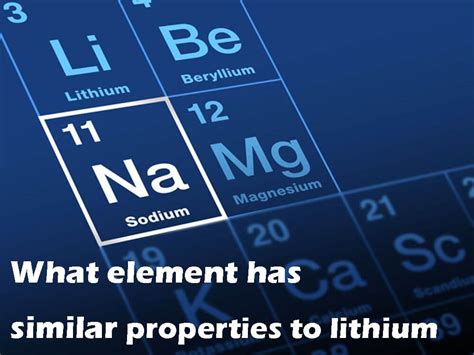Lithium, the lightest metal on the periodic table, possesses unique characteristics that make it an essential component in various applications, from rechargeable batteries to pharmaceuticals. Its distinctive properties, such as low density, high reactivity, and exceptional electrochemical properties, have led to its widespread use in modern technologies. However, scientists have discovered other elements with similar characteristics to lithium, offering potential alternatives for various applications.

Sodium: A Close Relative with Similar Properties
Sodium, the next element after lithium in the alkali metal group, shares several similarities with its predecessor. Both elements exhibit high reactivity, readily losing an electron to form cations with a charge of +1. This property enables them to participate in various chemical reactions and act as effective reducing agents.
- Atomic Number: 11
- Atomic Weight: 22.99
- Melting Point: 97.6 °C
- Boiling Point: 892 °C
- Density: 0.97 g/cm³
Sodium’s abundance and lower cost compared to lithium make it a more economical option for certain applications. However, its higher density and lower electrochemical potential limit its use in high-performance batteries.
Rubidium: A Heavier Alkali Metal with Enhanced Properties
Rubidium, the fourth alkali metal, possesses properties that amplify those of lithium and sodium. Its significantly lower melting and boiling points, combined with increased softness and malleability, expand its potential applications.
- Atomic Number: 37
- Atomic Weight: 85.47
- Melting Point: 39.3 °C
- Boiling Point: 688 °C
- Density: 1.53 g/cm³
Rubidium’s enhanced electrochemical properties, including a higher discharge capacity and lower self-discharge rate, make it a promising candidate for long-lived batteries. However, its rarity and high cost hinder its widespread adoption.
Potassium: A Versatile Alkali Metal with Diverse Applications
Potassium, the fifth alkali metal, exhibits a combination of properties similar to lithium, sodium, and rubidium. Its moderately high reactivity and excellent electrical conductivity make it suitable for various applications.
- Atomic Number: 19
- Atomic Weight: 39.0983
- Melting Point: 63.3 °C
- Boiling Point: 770 °C
- Density: 0.86 g/cm³
Potassium’s biological importance in regulating blood pressure and nerve function has led to its widespread use in medical applications. Its versatility extends to the agricultural industry, where it serves as a primary nutrient for plants.
Exploring Applications of Elements with Lithium-Like Properties
Energy Storage: Elements with lithium-like properties, particularly sodium, rubidium, and potassium, hold immense potential in energy storage systems, such as batteries and supercapacitors. Their high reactivity and electrochemical stability enable them to store and release electrical energy efficiently.
Electrochemical Cells: These elements are essential components of electrochemical cells, where they undergo redox reactions to generate electrical energy. Their unique electrochemical properties, including high discharge capacity and low self-discharge rates, make them suitable for various applications, including wearable devices and electric vehicles.
Pharmaceuticals: Rubidium and potassium play crucial roles in pharmaceuticals and medical applications. Rubidium-82 is used in medical imaging, while potassium is vital for maintaining electrolyte balance and regulating nerve function.
Electronics: Lithium-like elements find applications in the electronics industry due to their excellent electrical conductivity. Sodium-ion capacitors, for example, can provide high-power and long-lasting energy sources for electronic devices.
Tips and Tricks for Identifying Elements with Lithium-Like Properties
- Reactivity: Look for elements that exhibit high reactivity, readily losing an electron to form cations with a charge of +1.
- Electrochemical Potential: Consider elements with high electrochemical potentials, indicating their ability to undergo redox reactions effectively.
- Density: Elements with low density, similar to lithium, are more suitable for applications requiring lightweight materials.
- Abundance: Identify elements that are relatively abundant and cost-effective for practical applications.
Conclusion
Elements with similar properties to lithium offer a range of alternatives for various applications. Sodium, rubidium, and potassium, in particular, possess characteristics that complement or surpass those of lithium. By exploring the properties and potential of these elements, scientists and engineers can develop novel solutions for energy storage, electronics, medical devices, and beyond.
Table 1: Comparison of Properties of Lithium and Similar Elements
| Property | Lithium | Sodium | Rubidium | Potassium |
|---|---|---|---|---|
| Atomic Number | 3 | 11 | 37 | 19 |
| Atomic Weight | 6.94 | 22.99 | 85.47 | 39.0983 |
| Melting Point (°C) | 179 | 97.6 | 39.3 | 63.3 |
| Boiling Point (°C) | 1342 | 892 | 688 | 770 |
| Density (g/cm³) | 0.534 | 0.97 | 1.53 | 0.86 |
Table 2: Electrochemical Properties of Lithium and Similar Elements
| Property | Lithium | Sodium | Rubidium | Potassium |
|---|---|---|---|---|
| Standard Reduction Potential (V) | -3.05 | -2.93 | -2.93 | -2.92 |
| Discharge Capacity (mAh/g) | 3862 | 1166 | 457 | 270 |
| Self-Discharge Rate (per year) | 1-3% | 2-5% | <1% | 1-3% |
Table 3: Potential Applications of Elements with Lithium-Like Properties
| Element | Application |
|---|---|
| Sodium | Sodium-ion batteries, supercapacitors |
| Rubidium | Medical imaging, pharmaceuticals |
| Potassium | Electrolyte balance, nerve function, agriculture |
Table 4: Advantages and Disadvantages of Elements with Lithium-Like Properties
| Element | Advantages | Disadvantages |
|---|---|---|
| Sodium | Abundant, inexpensive | Lower electrochemical potential, higher density |
| Rubidium | Enhanced electrochemical properties | Rare, expensive |
| Potassium | Biological importance, versatile applications | Lower discharge capacity |
